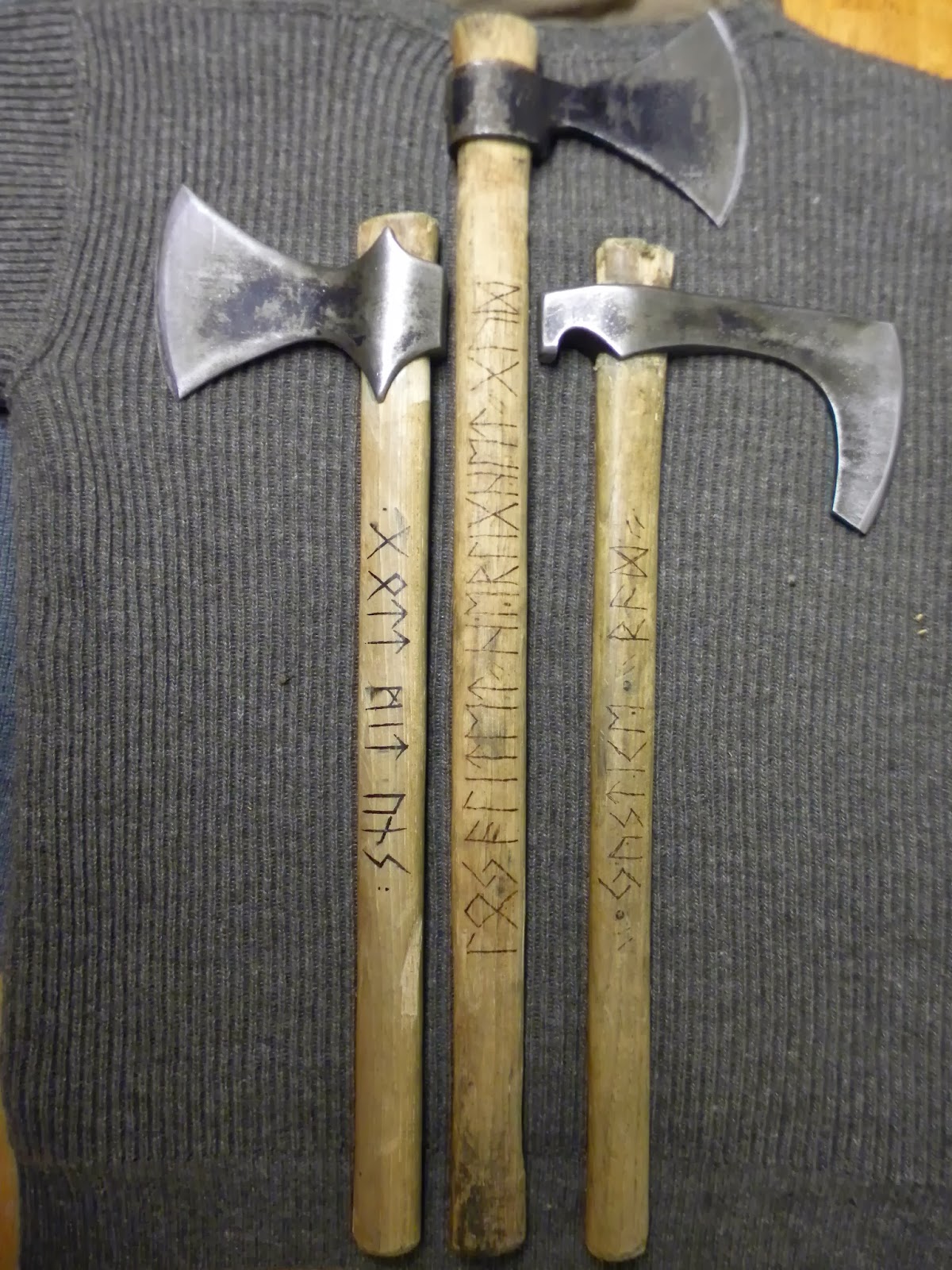Helle Fabrikker is a company in Holmedal, a small Norwegian town built along a Fjord. Helle knives are not mass produced, in fact each knife is hand made. Each blade is individually hand ground to a skinning sharp edge. Many Helle knives including the Viking use a unique Curly Birch (Betula pendula?) wood for the handles. Each handle made of Curly Birch is unique and truly one of a kind as no two pieces are exactly the same. In Viking times everyone was expected to have and need a knife, even slaves by law were guaranteed the right to keep knives. The Viking is a historically accurate recreation of the common belt knife worn by Scandinavians, including the vikings, nearly 1000 years ago.
This picture is courtesy of http://jorvik-viking-centre.co.uk/about-jorvik/gallery/ and shows some Viking age artifacts discovered near York, England at the Jorvik excavation. The botton knife in the picture looks the most like the Helle Viking.
I am 3/4ths Norwegian with one side coming from Meløy, Norway. It almost feels like reaching for a family heirloom whenever I put this knife on my belt before hitting the field. The difference between Scandinavian knives goes something like this: Swedish people could care less what a knife looks like and don't want to spend too much money on one as long as it is Sharp, so their knives tend to be slightly more bland. Norwegians on the other hand want both a knife that looks good and is extremely sharp and is made and expected to last a couple generations and come out of the box sharper than Swedish knives. The Finnish knives land somewhere between the two looking nicer than the Swedish knives but not being quite as sharp as the Norwegian blades. The other two cannot compare with the triple laminated blade of Helle.The package as mailed comes with the Sheathed knife, sharp as a razor, a cloth, which I ended up using to wipe the oil off the blade when I sharpen it, and the shipping tube.
The Viking is designed after viking belt knives that have been discovered around Norway. Being of Norse heritage myself, that was one large selling point.
The blade has a grind called a Scandinavian Grind. It has a wide flat bevel that runs to the edge of the blade. The Viking has no secondary bevel. This makes for an extremely easy knife to sharpen on a whetstone. In the instructions Helle pretty much says to never sharpen without oil or water. This is the only knife I own which gets pampered and sharpened on the whetstone, while all of my other knives get sharpened on the Work Sharp Knife Sharpening System. Due to the triple lamination of the blade, I'm pretty sure the heat on the blade would not be good for the knife, and the Scandi grind would also be removed if I used the Work Sharp. Another nice thing about the Scandi grind is that it keeps an edge superbly sharp for a long time.
Triple laminated blades are also something that is unique to Norwegian knives. A high carbon piece of stainless steel is sandwiched between two tough pieces of 18/8 stainless steel. This makes for a blade that takes and keeps an extremely sharp edge and yet isn't so brittle that it shatters. The triple laminated steel is most easily noticed on this side by the faint line almost directly in the middle of the bevel on the blade. The blade is 4 7/16" long and the handle is 4 3/16" long. The overall length comes out to about 8 10/16" long which is about perfect for a working belt knife. Each blade is individually hand ground and you can tell by the fact that the grind is a little bit heavier on one side than the other. This is merely a finicky appearance issue and is not a problem in any way to me. They also leave the blade rough and forge blackened after the forging process creating more of a traditional look. The blade is mostly left plain except for the Helle inscription on the left side of the blade.
The grain of the Curly Birch is a pretty sight and the balance is nice on mine, balancing on one finger exactly where the handle starts. The wood fits well in the hand and gives a solid hold due to the slight curve of the wood.
The Vikings blade is rather thick at .146", which is a good thing because it makes it more sturdy, but it will also make it harder to make small fillet-like cuts, but that's what a fisk kniv is for. This is showing the Vikings thickness as compared to the well known Olean, NY KA-BAR. The KA-BAR is .172" at its thickest and is about 2 1/2" longer in the blade.
You can see the similarity of design on these two very Scandinavian knives. The Rapala fisk kniv on the top coming from Finland and the Helle Viking being Norwegian. They both use the usual Scandinavian pouch style sheath which retains the kniv by using the friction of the rough leather against the wooden handle. I've never had one wiggle loose and I've taken them both ice fishing and cross-country skiing along with everyday wear. I use mink oil on all of my leather that doesn't "need" a shine. Pretty much all of my leather holsters and leather sheaths get the mink oil and the leather boots get the polish.If you want to learn more about how Helle makes these knives, more about blacksmithing, the Norwegian triple lamination process, or Scandinavian history in general http://www.ragweedforge.com/scankniv.html is where I got my knife and my tomahawks from.
He ships them fast and also makes both his own knives and his own tomahawks! He knows far more than I do when it comes to knife-lore and has a fun site you all should check out.









No comments:
Post a Comment